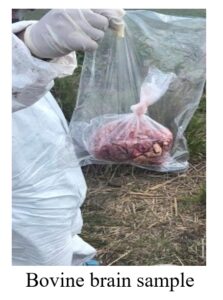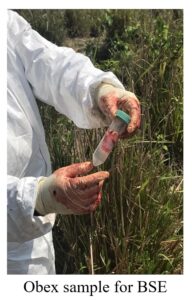Bovine Spongiform Encephalopathy (BSE)
Learn more about BSE
Bovine Spongiform Encephalopathy (BSE), also known as Mad Cow Disease, is a fatal disease of the nervous system that mainly affects cattle.
Cause and Transmission
Diagnosis
Signs of BSE in Animals
Signs of BSE are found in adult animals. This is due to the average time between an animal’s infection with the prion and the onset of signs normally 2 to 8 years. Signs may last for a period of 2 to 6 months before the animal dies. Animals with BSE may demonstrate some of the following signs:
- Nervous or aggressive behaviour.
- Depression.
- Hypersensitivity to sound and touch, twitching, tremors.
- Abnormal posture.
- Lack of coordination.
- Weight loss.
- Decreased milk production.
Treatment
Prevention
BSE can be prevented by not feed ruminant tissues that may contain prions to susceptible species. If cattle are disabled or non-ambulatory, they do NOT enter the food chain. Do NOT eat the brains of ruminants.
The prion cannot be killed by standard disinfection procedures or heat, which means that cooking the meat will not completely destroy it.
Control
Where does BSE occur?

Confusion with other diseases
BSE can be confused with other neurologic diseases such as rabies or nutritional deficits. Whenever neurologic signs are observed in your animals, report it to BLPA or BAHA so that tests can be made to determine whether the disease causing them is BSE.
Bovine Spongiform Encephalopathy (BSE) Surveillance
A revised standard on Bovine Spongiform Encephalopathy (BSE) has been adopted by the World Assembly of Delegates during the World Organization for Animal Health’s (WOAH) 90th General Session in 2023. Due to the successful implementation of effective control measures, bovine spongiform encephalopathy has turned from a public health emergency of international concern to a disease with contained presence and sanitary impact. The new text adopted represents a great achievement.
Today the incidence of BSE has dropped to nearly zero because most countries have implemented measure to avoid the recycling of specified risk materials. With the current scientific knowledge and evolving epidemiological context the standard on BSE was updated. The new standard changes cover the need for a complete disease risk assessment to determine the risk status of a country or a zone. It also allows for a simplified surveillance to better match with the reality in the field, while ensuring that minimum sanitary requirements are put in place by countries. The cost of implementing a point-based surveillance system is significant and countries with small cattle populations like Belize finds it difficult to meet such requirements.
The simplification and cost reduction of surveillance methods will not lead to a reduction in its effectiveness, rather it will be a more flexible system based on field clinical screening that reflects current scientific information. The changes in the surveillance requirements will provide an incentive for countries that have not gained an official risk status to apply for one.
With the adoption of the revised standard, access to trade will be facilitated thereby accelerating economic development, food security will be improved, while the likelihood of new BSE cases will continue to decrease.
A new Controlled BSE Risk Status Requirement
These are now the new requirements for a CONTROLLED BSE RISK Status as per the WOAH:
The BSE risk of a country or zone can be controlled provided all of the following conditions are met, but one or more of these conditions has not been met for the preceding eight years.
- A risk assessment that has identified all potential risk factors associated with classical BSE has been conducted, and the Member Country has demonstrated through documented evidence that any identified risk factors have been adequately managed and that the risk of the classical BSE agent being recycled within the bovine population has been negligible because of:
EITHER
livestock industry practices ensuring that protein meal derived from ruminants has not been fed to ruminants.
OR
effective and continuous mitigation of each identified risk ensuring that protein meal derived from ruminants has not been fed to ruminants.
- The surveillance provisions as described below have been implemented*
- EITHER:
- there has been no case of BSE or, if there has been a case, each case of BSE has been demonstrated to have been imported.
OR - if there has been an indigenous case of BSE:
either:
- Any cases of BSE or any bovines affected by atypical BSE that have been detected have been destroyed or disposed of to ensure that they do not enter the feed or food chain.all cases were born before the date from which the risk of BSE agents being recycled within the bovine population has been negligible.
or - where a case was born after that date, subsequent investigations have confirmed that any identified source of infection has been controlled and the risk of BSE agents being recycled within the bovine population has continued to be negligible
- all cases were born before the date from which the risk of BSE agents being recycled within the bovine population has been negligible.
- Any cases of BSE or any bovines affected by atypical BSE that have been detected have been destroyed or disposed of to ensure that they do not enter the feed or food chain.all cases were born before the date from which the risk of BSE agents being recycled within the bovine population has been negligible.
- there has been no case of BSE or, if there has been a case, each case of BSE has been demonstrated to have been imported.
Any cases of BSE or any bovines affected by atypical BSE that have been detected have been destroyed or disposed of to ensure that they do not enter the feed or food chain.
*Surveillance
The objective of BSE surveillance is to detect occurrence of BSE within the bovine population.
I. BSE is a progressive, fatal disease of the nervous system of bovines that usually has a harmful onset with no treatment. A range of clinical signs that vary in severity and between animals have been described for classical BSE:
- Progressive behavioural
 changes that are refractory to treatment such as increased excitability, depression, nervousness, excessive and asymmetrical ear and eye movements, apparent increased salivation, increased licking of the muzzle, teeth grinding, hypersensitivity to touch and/or sound (hyperaesthesia), tremors, excessive vocalization, panic-stricken response, and excessive alertness.
changes that are refractory to treatment such as increased excitability, depression, nervousness, excessive and asymmetrical ear and eye movements, apparent increased salivation, increased licking of the muzzle, teeth grinding, hypersensitivity to touch and/or sound (hyperaesthesia), tremors, excessive vocalization, panic-stricken response, and excessive alertness. - Postural and locomotory changes such as abnormal posture (dog sitting), abnormal gait (particularly pelvic limb ataxia), low carriage of the head, head shyness, difficulty avoiding obstacles, inability to stand and recumbency.
- Generalized non-specific signs such as reduced milk yield, loss of body condition, weight loss and slow heart rate (bradycardia).
- Progressive behavioural
The clinical signs of BSE usually progress on a spectrum over a few weeks to several months, but on rare occasions cases can develop acutely and progress rapidly. The final stages of the disease are characterized by recumbency, coma and death.
II. Surveillance for BSE includes all bovines that show signs of the clinical spectrum of BSE.
The surveillance programme should consider that most cases of BSE arise as single, isolated events. The concurrence of multiple animals with behavioural or neurological signs, or non-ambulatory or fallen stock is most likely associated with other causes.
concurrence of multiple animals with behavioural or neurological signs, or non-ambulatory or fallen stock is most likely associated with other causes.
The animals that lie on the clinical spectrum of BSE should be targeted for BSE surveillance and the following animals should be reported and followed up with appropriate laboratory testing in accordance with the Terrestrial Manual to accurately confirm or rule out the presence of BSE agents, including discrimination between atypical and classical BSE strains.
- those displaying progressive clinical signs suggestive of BSE mentioned in point 1 that are refractory to treatment, and where the clinical presentation cannot be attributed to other common causes of behavioural or neurological signs (e.g. infectious, metabolic, traumatic, neoplastic, or toxic causes).
- those showing behavioural or neurological signs at ante-mortem inspection at slaughterhouse/abattoirs.
- those unable to rise or walk without assistance, with an appropriate supporting clinical history (i.e. the clinical presentation cannot be attributed to other common causes of recumbency).
- those found dead (fallen stock), with an appropriate supporting clinical history (i.e. the clinical presentation cannot be attributed to other common causes of death).
III. The credibility of the surveillance programme is supported by:
- ongoing awareness and training programmes to ensure that all those stakeholders involved in the rearing and production of livestock, including bovine breeders, owners and keepers, veterinarians, transporters, and slaughterhouse/abattoir workers are familiar with the clinical signs suggestive of BSE as well as the statutory reporting requirements.
- the fact that BSE is a notifiable disease throughout the whole territory.
- appropriate laboratory testing in accordance with the Terrestrial Manual.
- robust, documented, evaluation procedures and protocols for:
- the definition of the target population for BSE surveillance,
- the reporting of bovines described in points II a) to 2 d),
- the determination of animals to be subjected to laboratory testing,
- the collection and submission of samples for laboratory testing,
- the follow-up epidemiological investigations for BSE positive findings.
The way forward for Belize
- Develop a BSE Manual as required by the Terrestrial Manual in the section under Surveillance.
- Ongoing public awareness and Surveillance.
- For 2023 a total of 32 samples were obtained. Eleven (11) samples were positive for Rabies (mostly in Orange District) and 11 samples were submitted for BSE with 5 pending for testing.
- Obtain a copy of the BSE Risk Assessment of Belize conducted by Dr. Luis Espinoza.
- Preparation of the BSE Dossier.
- Request to OIRSA for the perusal of BSE expert.
Note: The new standards come into effect after MAY 2024.
For Further Information contact Belize Livestock Producers Association (BLPA) or the Belize
Agricultural Health Authority (BAHA) at:
BLPA Office
Tel: (501) 675-3883
BAHA Office
Central Farm
Tel: (501) 824-4899 / 4872
Fax: ( 501) 824-4889
E-mail: [email protected]
BAHA Office – Orange Walk Town
Tel: (501) 322-3257 / 2301
Fax: (501) 322-2301
